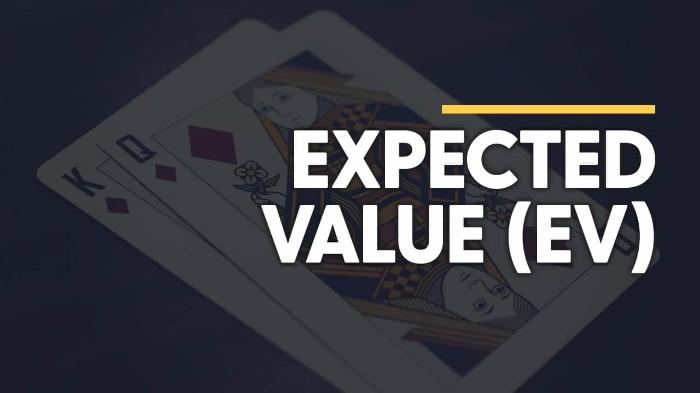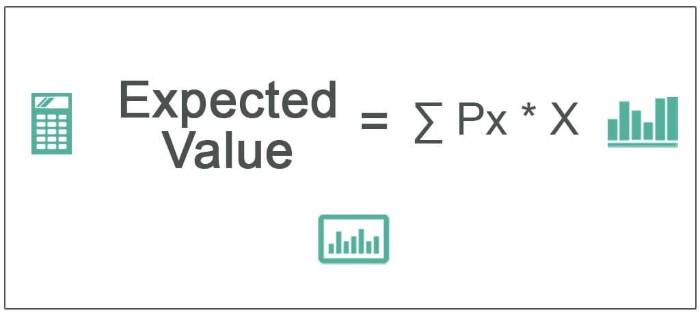Are you interested in understanding the concept of expected value (EV)? Do you ask, "What is EV?" and wonder how it affects decision-making? This article describes EV and reviews a few examples demonstrating its application.
We'll also discuss why it's such an important concept to master for those looking to gain a competitive edge over others who don't understand or use it. With the knowledge gained from this blog post, you should be able to confidently utilise EV in your future decisions—let's dive right in!
Definition of Expected Value (EV)

Expected value (EV) is a key concept in decision-making and game theory. It describes the expected outcome of an action based on the probability of a given event occurring. In other words, it's the average result you can expect when repeating an experiment multiple times.
For example, if you roll a dice six times and the probability of getting a four is 1/6, then the expected value of rolling that dice six times will be one-four.
Explaining the Concept of EV

Expected Value (EV) is a concept used to evaluate potential outcomes of an action or decision. It helps us quantify the likelihood of each outcome so we can make informed decisions based on our risk/reward preferences.
EV is calculated by multiplying the probability of success for each possible outcome and adding them together. The result is the expected value, which allows us to compare different options and pick one that maximises our rewards while minimising risks.
For example, if you're gambling on a coin toss, your EV would be the sum of 0.5 x win amount + 0.5 x loss amount = 0 because there's a 50% chance of winning and a 50% chance of losing. The expected value would be 0 in this scenario because there is no overall gain or loss.
EVs can also be used when considering investments and other decisions. The expected value is calculated by multiplying the probability of success for each possible outcome and adding them together. This allows us to compare different options and select one that maximises our rewards while minimising risks.
Different Examples of EV in Various Contexts
Expected value (EV) is a core concept in decision-making and risk analysis. It quantifies the expected return from an uncertain event, such as playing a game or investing in stocks. Simply put, the expected value of an action or outcome is the sum of all potential payoffs multiplied by their respective probabilities.
For instance, if you were to flip a fair coin with two sides labelled “Heads” and “Tails”, then your EV would be equal to 50% × $1 payout + 50% × (-$1 payout) = 0. In this case, the payoff for heads is $1, while tails carry no reward; thus, the EV equals zero because there is an equal chance of winning or losing.
EVs can also be used to assess the potential of investments. For example, if you were considering buying a stock with a 20% chance of doubling and an 80% chance of losing half its value, your EV would equal 0.2 × 2 payoff + 0.8 × (-0.5 payoff) = 0.
In this case, the expected return is zero—you are equally likely to win or lose money on your investment decision. It's important to remember that EV only provides an expected outcome; the actual result may differ from what was predicted based on probability alone.
EV is also applicable when playing games such as poker or blackjack. Suppose you're playing Texas Hold 'em and have four Kings in your hand. The expected return would be calculated by considering the likelihood of success for each card combination and the corresponding reward or loss associated with each scenario.
This calculation could include factors such as the probability of winning, the chips wagered, and any other potential payouts (e.g., bonuses). By analysing this information through EV analysis, you can make an informed decision on whether or not to proceed with a predetermined strategy.
How EV is Used In Decision-Making And Investment Strategies
Expected value (EV) is a concept that has been used in decision-making and investment strategies for decades. The mathematical expectation of a random variable over time or the average outcome can be expected when faced with various possible decisions.
EV helps evaluate outcomes by calculating the probability of each possible result and multiplying it by its associated payoff or loss. This resulting figure gives individuals an idea of what they can anticipate from their chosen course of action.
By considering different scenarios and their respective probabilities, investors and other decision-makers can make more informed judgments about where to invest capital or which choices will give them the best prospects for success.
For example, if someone was evaluating two stocks with identical price points but different expected returns, they could apply EV to predict which one is more likely to provide a higher rate of return.
In addition, EVs can be used as part of an overall risk management strategy by helping individuals weigh up potential losses with anticipated rewards when deciding on an investment or other initiative.
By understanding how expected value works and its application in decision-making, investors can make more informed decisions that are better positioned for success.
Tips For Calculating EV in Daily Life Decisions
Once you understand what expected value (EV) is and how to calculate it, you can apply it to your daily life decisions. Here are a few tips to help you get the most out of EV.
Estimate Your Risk
Before calculating EV, estimating the risk associated with an action or decision is important. This will give you a more realistic view of the likely outcomes and help you make a better decision.
Consider Your Time Horizon
When considering different options, always think about time horizons – short-term versus long-term results. EVs can be useful for short-term decisions, but their true power lies in helping us make informed choices about our future actions over a longer period.
Determine Your Goals
Before calculating EV, it’s important to understand your goals and how they relate to the decision. Having a clear goal, you can better determine which option will likely yield the most favourable outcome.
Balance Risk & Reward
Calculating EV allows you to balance risk and reward when making decisions – ensuring that both sides of the equation are considered before moving forward with any action or investment.
Analyse Alternatives
When faced with multiple options, take the time to analyse each alternative through EV calculation – this will ensure that you make an informed decision based on data rather than emotion.
FAQs
What is the rule for expected value?
Expected value is the mathematical expectation of a random variable—the sum of all possible values multiplied by its probability. It estimates the average outcome when repeating an experiment multiple times.
Why do we need expected value?
Expected value is an integral part of decision-making and risk analysis. It allows us to compare outcomes based on expected values, which helps inform our decisions. Knowing EV can help us decide between two or more options with a better understanding of the possible consequences.
Is the expected value always a number?
The expected value can also represent a probability or range of values. For example, if the expected value is 0.5, there's a 50/50 chance of the outcome being either one way or the other. It can also be expressed as a range, such as an interval of 0-1 (where 1 indicates certainty). In this case, the expected value is uncertain.
Conclusion
Expected value (EV) is important to understand when making decisions, especially concerning gambling or investments. Understanding and calculating expected value will help us make more informed and effective decisions and allow for a wide range of settings and user preferences. Furthermore, by relying on EV rather than our gut feelings alone, we can discover opportunities where there may have been none. As such, the next step is to practice using the expected value in daily life decision-making and investment strategies.

Western Union: Everything You Need to Know for Smooth Transactions

What Is the Average Profit Margin for a Company in the Banking Sector?

What are the Best Online Checking Accounts You Should Consider?

Understanding the Role and Responsibilities of a Lessee

Navigating the World of Membership Organizations and Their Impact on Health Insurance

What Is Expected Value (EV)?

How YouTube Makes Money Off Videos

A Comprehensive Guide for Capital Gains Tax Exclusion for Primary Residences

Strategies for Managing Fixed-Income Securities

Why Your Home Is Stuck on the Market: Key Issues to Address

How to Calculate Property Taxes
